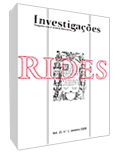O Simulacro em Memórias Póstumas de Brás Cubas: Outra Visão do Narrador
Abstract
Utilizando o conceito de simulacro na acepção que lhe confere Baudrillard (1991), a análise ora proposta tem como finalidade verificar, no texto literário e nos textos fílmicos, como o narrador Brás Cubas formula seu discurso e, por conseguinte, seu metadiscurso, de maneira a gerar imagens de si como personagem e transmitir uma confiabilidade com o intuito de gerar no leitor/espectador o efeito de verossimilhança em relação ao exposto, quando o narrador não passa de uma simulação da realidade, simulacro.References
ASSIS, Machado de. 1997. Memórias póstumas de brás cubas. 23ª ed. São Paulo: Ática.
AUMONT, Jacques et al. 1994. A estética do filme. São Paulo: Papirus Editora.
BAUDRILLARD, Jean. 1991. Simulacros e simulação. Trad.: Maria João da Costa Pereira. Lisboa: Relogio d'Agua.
BAVCAR, Evgen. 2005. A imagem, vestígio desconhecido da luz. In:NOVAES, Adauto (Org.). Muito além do espetáculo. São Paulo: Editora Senac.
COSTA, Beatriz. Aprendiz de Paulo Emílio. Disponível em: http://www.cinemando.com.br/200211/entrevistas/andreklotzel_01.htm > Acesso em: 03 de ago. 2007.
DELEUZE, Gilles. 1974. Lógica do sentido. Trad.: Luiz Roberto Salinas Fortes. São Paulo: Perspectiva, EDUSP.
GENETTE, Gérard. 1979. Discurso da narrativa. Ensaio de método. Lisboa: Arcádia.
HUTCHEON, Linda. 1985. Uma teoria da paródia. Lisboa: Edições 70.
Downloads
Published
How to Cite
Issue
Section
License
Copyright (c) 2008 Germana da Cruz Pereira

This work is licensed under a Creative Commons Attribution 4.0 International License.
Authors who publish with Revista Investigações agree to the following terms:
Authors retain copyright and grant the journal right of first publication with the work simultaneously licensed under the Creative Commons Attribution 4.0 International (CC BY 4.0) license that allows others to share the work with an acknowledgement of the work's authorship and initial publication in this journal.
Authors are able to enter into separate, additional contractual arrangements for the non-exclusive distribution of the journal's published version of the work (e.g., post it to an institutional repository or publish it in a book), with an acknowledgement of its initial publication in this journal.
You are free to:
Share — copy and redistribute the material in any medium or format for any purpose, even commercially.
Adapt — remix, transform, and build upon the material for any purpose, even commercially.
The licensor cannot revoke these freedoms as long as you follow the license terms.
Under the following terms:
Attribution — You must give appropriate credit , provide a link to the license, and indicate if changes were made . You may do so in any reasonable manner, but not in any way that suggests the licensor endorses you or your use.
No additional restrictions — You may not apply legal terms or technological measures that legally restrict others from doing anything the license permits.

